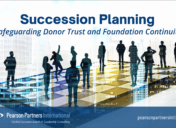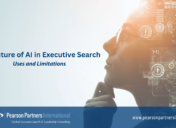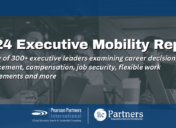Future Texas: Industry and Innovation in the Texas of Tomorrow
Texas is on a remarkable trajectory, leading the nation in population growth, job creation and industrial innovation. As home to more Fortune 500 companies than nearly any other state—and with a GDP that, if it were a country, would make it the eighth-largest economy in the world—Texas stands at the forefront of America’s future economic growth.
But with that success comes a new set of challenges: How does Texas manage the infrastructure demands of a growing population? What are the energy implications of rapid industrial expansion? And how can the state continue to foster talent development and retention to maintain its competitive edge in an increasingly globalized economy?
These were just a few of the questions explored at Pearson Partners International’s recent Spotlight Series™ breakfast, held September 10 at Park City Club in Dallas. The event drew senior executives and business leaders from across the region to discuss “The Texas of Tomorrow.” Moderated by Renee Arrington, President and COO of Pearson Partners International, the conversation centered on how industry and innovation will shape Texas’ future—and what business leaders can do today to help guide the way.
Texas: A Powerhouse Economy with Room to Grow
In her opening remarks, Arrington painted a vivid picture of Texas’ economic heft. With a GDP of $2.4 trillion, Texas would be the eighth-largest economy in the world if it were a country, surpassing countries such as Brazil, Canada, Italy and South Korea. Texas is the second state in the U.S. to reach a population of 30 million residents—and it is not slowing down. “We are adding 1,000 people to our state every single day,” Arrington noted, citing projections that put the state’s population at over 40 million by 2060.
This growth has accompanied a surge in business investment and corporate relocation. Texas is now home to 55 Fortune 500 companies, with 24 in the Dallas-Fort Worth area. The state’s financial services hub is booming, luring powerhouses like Goldman Sachs, JPMorgan Chase, Charles Schwab and Fisher Investments and earning the city the nickname “Y’all Street.” The NYSE is moving its Chicago branch to Dallas and reincorporating it as NYSE Texas. Over 200 companies have relocated to Texas since 2020, including Chevron, Oracle, Google, Tesla, HP, McKesson and others.
At the same time, the state’s economic success raises important questions about sustainability, infrastructure and long-term planning.
“How do we support the underpinnings of what makes our state great so Texas can continue to be a magnet for people, business and innovation?”
– Renee Arrington, President & COO, Pearson Partners International
The Power Conundrum: Balancing Growth with Grid Reliability
One of the most pressing infrastructure challenges Texas faces is energy. The state’s grid has struggled to keep up with demand, particularly during extreme weather events like Winter Storm Uri in 2021. A panelist with extensive expertise in energy strategy and sustainability explained that Texas’ competitive energy market is unique in several ways. Unlike other regional power grids in the U.S., the ERCOT (Electricity Reliability Council of Texas) grid is largely isolated, or “islanded,” meaning it cannot easily draw power from outside sources when demand surges.
While Texas has led the nation in deploying renewable energy—particularly wind and solar, which have grown five-fold in Texas in the last 20 years—dispatchable generation such as natural gas and nuclear power has remained flat for nearly two decades. In 2010, dispatchable generation made up 92 percent of the state’s energy portfolio. By 2023, that number had dropped to 48 percent with renewables and battery storage accounting for the balance.
“The renewable growth is exactly what we want,” the panelist noted. “But on those very hot or very cold days, when the sun isn’t shining and the wind isn’t blowing, we need reliable, on-demand power. And we’re not building enough of it.”
Despite the challenges of balancing its energy mix, Texas continues to lead the nation in renewable energy generation. The state ranks No. 1 in the country in wind power capacity and is rapidly expanding its solar energy output, outpacing many other U.S. states in clean energy investment. Panelists highlighted that Texas’ vast land resources, favorable regulatory environment and innovative private sector have made it a global model for renewable energy deployment. However, as one panelist noted, while renewable energy now accounts for over 50 percent of Texas’ energy resources on an average day, it must be paired with dispatchable generation to ensure reliability during periods of high demand. The challenge moving forward is not a lack of renewable energy leadership, but ensuring a resilient, flexible grid that can support continued economic growth and decarbonization goals.
Programs like the Texas Energy Fund encourage new investment in dispatchable generation, particularly natural gas plants. However, there is concern that government subsidies—while helpful in the short term—could distort the market and create long-term inefficiencies. “The best solution is a competitive market that works on its own,” the energy industry panelist emphasized, “but that requires the right investment signals and a clear understanding of the economics.”
Nuclear Energy: A Critical, Yet Complex, Component of the Future Grid
The conversation also delved into the role of nuclear energy in meeting Texas’ growing power needs. As one panelist explained, nuclear energy remains the only form of clean, carbon-free power that operates reliably 24/7. However, building new large-scale nuclear plants in the U.S. is fraught with regulatory challenges and astronomical costs. The most recent example is Georgia’s Vogel plant, which cost nearly $40 billion to build—a staggering sum compared to the $1 billion it typically costs to build a new natural gas plant in Texas.
While the economics of large-scale nuclear are daunting, panelists expressed cautious optimism about the potential of advanced nuclear technologies, such as small modular reactors (SMRs). These systems offer a smaller, less risky investment and could play an important role in the energy mix within the next decade. Texas’ Advanced Nuclear Working Group is actively exploring ways to bring these technologies to market.
“If we want to decarbonize the grid long term,” noted the energy industry panelist, “and I would argue we will do so by 85 years or more in the future, then you have to have nuclear because it doesn’t work otherwise.”
The Role of Public Policy in Shaping Texas’ Future
The discussion also highlighted the critical role of national and state policy in shaping Texas’ future. Several panelists noted that federal subsidies for renewable energy have skewed the ERCOT market, making it difficult for new investments in natural gas and nuclear to compete on equal footing. Yet without government support, some sectors—such as space and advanced nuclear—may struggle to scale.
“Texas has all the resources it needs to lead,” one panelist concluded. “But what we lack is a long-term policy vision. We need to think in terms of decades, not just election cycles.”
Global Connectivity Starts with Talent Development
A recurring theme in the discussion was talent—attracting it, developing it, and keeping it in Texas. One panelist, a former defense industry CEO, stressed that while Texas is growing in population, it is behind in long-term investment in education and research.
“Talent development doesn’t happen overnight,” a panelist said. “It’s a multi-decade investment that starts in early education and carries through universities and research institutions.”
Fort Worth is an example of a city poised for transformation. Despite being the 12th largest city in the U.S., Fort Worth lacks a leading research university. That is beginning to change. Texas A&M is establishing a new engineering campus there, and UT Arlington has announced plans to expand west of the city. These developments are part of a broader push to create a high-tech innovation zone that can rival those in Boston, California and New York.
One panelist likened this long-term investment to the establishment of a new ecosystem. “It’s not just about getting degrees,” he explained. “It’s about building the infrastructure for innovation, attracting global commerce, and making Texas a hub for collaboration with other states and countries.”
Space: The Next Frontier for Texas Innovation
Texas’ pioneering spirit has long been part of its identity, and that ethos continues in the state’s central role in the private space industry. A panelist with deep experience in space investment described how Texas has been instrumental in the development of private space exploration. While Houston has long been home to NASA’s Johnson Space Center—ground control for America’s early manned space missions and a key player in the space shuttle program and the International Space Station—other regions of Texas are now accelerating the growth of the private space sector. SpaceX has announced its plan to relocate to Austin, and the state now hosts a growing ecosystem of aerospace startups, including those focused on small satellite technology and 3D-printed rocket motors.
The same panelist credited Dallas’ business-friendly environment with helping to make private space ventures viable. She explained, “I would argue that Dallas is the reason there’s a private space industry in the world today,” citing the Ansari family’s role in funding early private space initiatives after building their telecom fortune in North Texas. Their sponsorship of the Ansari X-Prize for space exploration led to the development of Burt Rutan’s SpaceShipOne, the first privately funded spacecraft—and the predecessor to Richard Branson’s SpaceShipTwo (SS2), now part of Virgin Galactic’s commercial spaceflight program.
“I would argue that Dallas is the reason there’s a private space industry in the world today,” said one panelist.
The newly established Texas Space Commission, appointed by Governor Abbott, underscores the state’s commitment to advancing this sector. The commission’s emerging public-private partnerships are paving the way for the state to play an even larger role in the global space economy.
What’s Next for Dallas and Texas?
The consensus among the panelists was clear: Texas must balance short-term needs with long-term vision. Thoughtful, strategic planning is essential in energy, space, defense, education and advanced manufacturing.
“We have all the ingredients for success. But we need to be intentional in how we leverage them.”
– Renee Arrington, President & COO, Pearson Partners International
As the discussion concluded, Pearson Partners Advisor Dr. Robert Potter posed a final question to the panel: Where will Dallas rank among the most populous U.S. cities in 2050? The unanimous prediction: By 2050, Dallas will rise from its current position as fourth to become the second most populous city in the country.
In his remarks, Keith Pearson, Chairman and CEO of Pearson Partners International, underscored the importance of conversations like these:
“This is an exciting time to be in Texas. But to fully realize our potential, we need collaboration—across industry, government and education—to meet the challenges ahead.”
– Keith Pearson, Chairman and CEO, Pearson Partners International
Pearson Partners International will continue to facilitate these critical discussions through its quarterly Spotlight Series™ events, helping business leaders navigate the evolving landscape of Texas’ economy and prepare for the future of industry and innovation.
Learn more about the Pearson Partners Spotlight Series™ breakfast events.
Related Posts
- ← 2024 Executive Mobility Report – Pearson Partners International & IIC Partners
- Build Your Talent Pipeline With Market Mapping – Pearson Partners International & IIC Partners →
















